|
   
 


A: Fern
salad: bird’s nest fern, salad dressing.
B: Fried
fern: bird’s nest fern, all purpose flour, eggs.
C:
Fern and dry anchovy stir-fry: bird’s nest fern,
dried anchovies, fermented beans.

1.
Harvesting bird’s nest fern. For our experimental
course, we asked Ms. Hsiu-shu Wen of community, who
plants a lot of bird’s nest fern, to teach us how to
harvest the fern. Ms. Wen told us that we should
look for the curling tender shoots of the bird’s
nest fern, and break it off about 15 centimeters
from its tip. When we tried harvesting ourselves,
the tender leaves of the bird’s nest fern broke off
with a crisp sound. While we were in the fern
garden, Ms. Wen kindly reminded us to watch out for
poisonous snakes that might be hiding under the
fallen leaves, which made us all really nervous and
jumpy during our harvest. Fortunately, we completed
our mission of harvesting bird’s nest fern without
further incident!
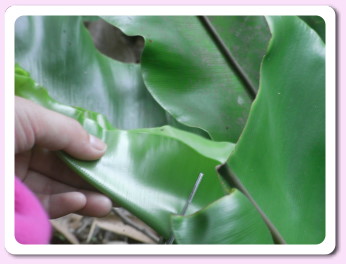 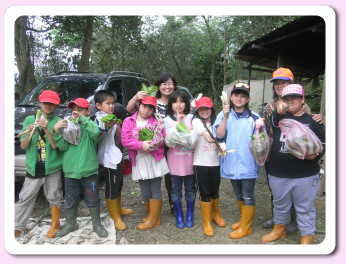
2. Washing bird’s nest fern. We
thought bird’s nest fern could be directly cooked
just as it is, but Ms. Hsiu-shu Wen told us that the
fine fuzz on the tender shoot of the bird’s nest
fern to give it a better taste and texture.
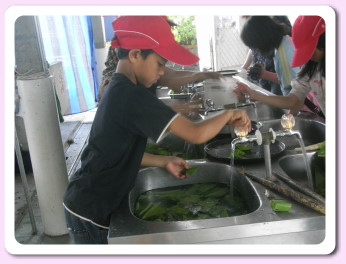 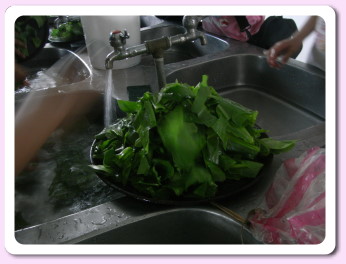
A.
Bird’s nest fern salad:
1. Break the fully washed fern
leaves into segments of 4 or 5 centimeters, blanch
them in boiling water, and when the leaves change
color cool them immediately in ice water. Ms.
Hsiu-shu Wen reminded us that a little bit of
cooking oil and salt can be added to the boiling
water to help retain the fern’s fresh green color.
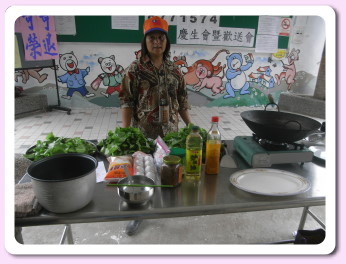 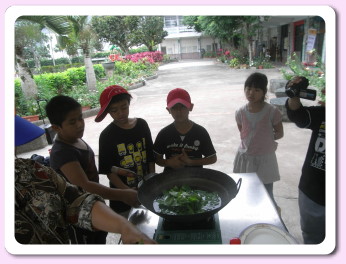
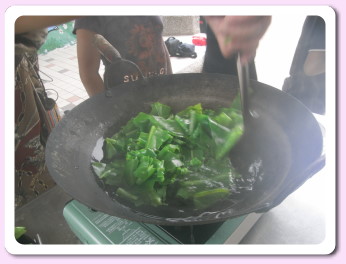 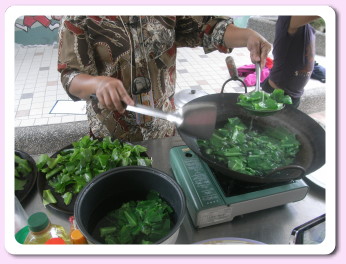
2.
Drain the leaves dry of ice water, place them into a
dish, and squeeze on some salad dressing! Now wasn’t
that simple! [up]
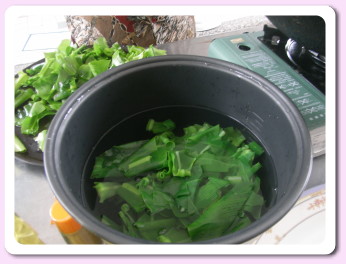 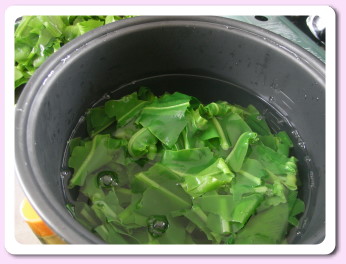
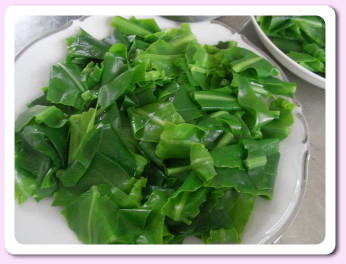 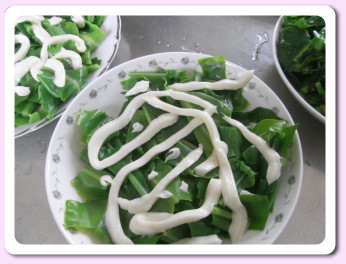
B. Fried bird’s
nest fern:
1. Add two eggs to a packet of all
purpose flour, then add some water and mix well.
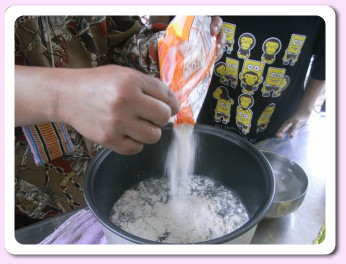 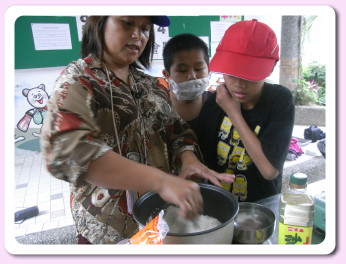
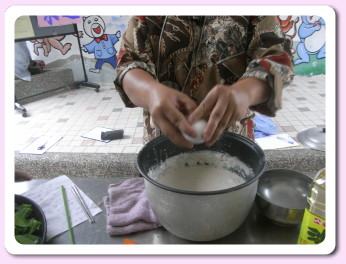
2.
Break the fully washed fern leaves into segments of
4 or 5 centimeters, dip them in the batter, and fry
them in hot oil. When the battered leaves turn a
golden color, remove from the pot and drain dry.
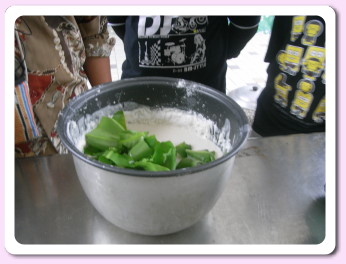 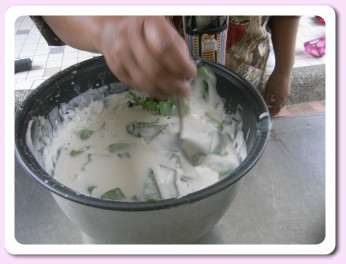
 
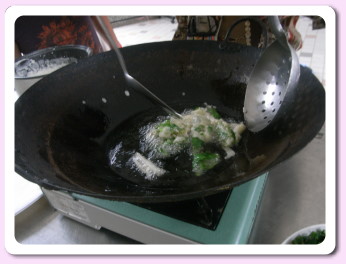
3.Freshly fried bird’s nest fern
is steaming and fragrant, and tastes great when
seasoned with salt and pepper. When you bite through
the crisp batter, you get a taste of the crunchiness
of the fern leaves. It’s the kind of dish you can’t
help asking more of, and is our favorite pick from
all the dishes we made.[up]
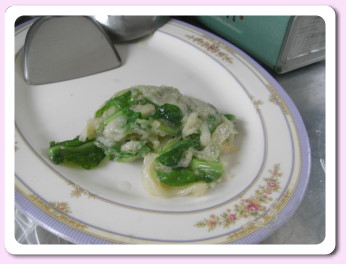 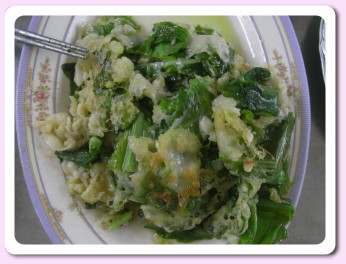
C. Fern and dry anchovy
stir-fry:
1.
Pour a little oil into a cooking pot, and fry the
dried anchovies and fermented beans.
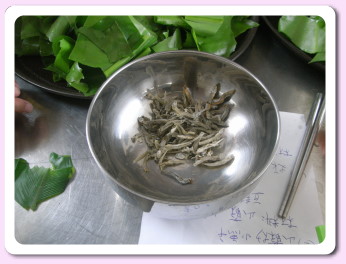 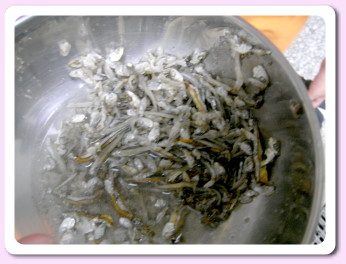
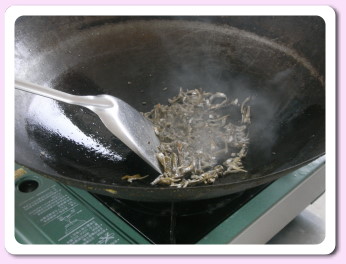
2.
Add the fully washed fern leaf pieces, a little
water, and stir-fry for 1 to 2 minutes on high heat.
If you cook the fern leaves for too long they become
wilted and yellow!
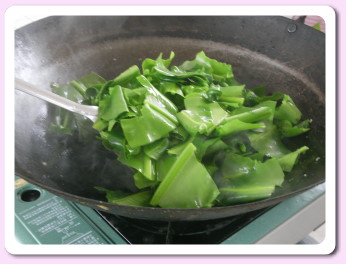 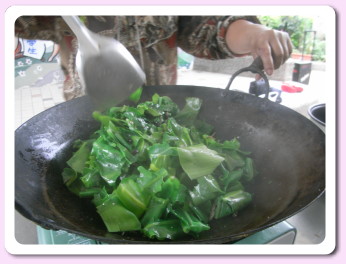
3.
Dried anchovies and fermented beans are both salty
ingredients, so it’s okay to not add any salt. If
you like heavier dishes, you may add a little salt
towards the ending of the cooking process.
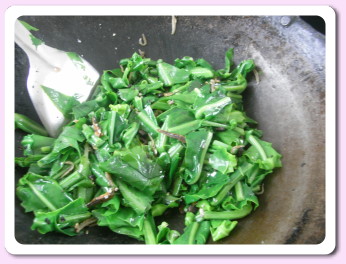 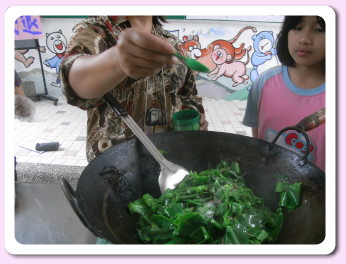
4. Freshly stir-fried bird’s
nest fern has a sparkly glaze. The wonderful crunchy
texture and salty flavor of the anchovies and
fermented beans makes you wish for bowl of rice to
go with it!
[up]
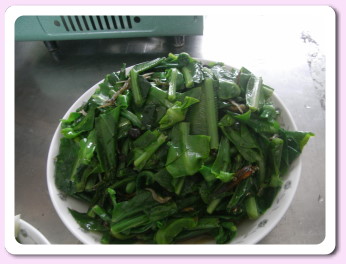 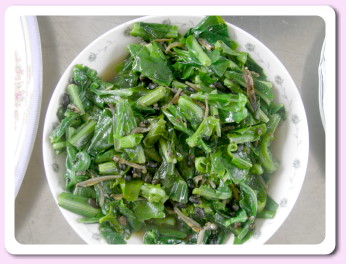

1. How do you
harvest bird’s nest fern?
When harvesting bird’s nest fern,
you can use scissors of knives, but the easiest way
is just to break it off with your hands. If you use
a knife, be careful not to cut yourself. Bird’s nest
ferns must be planted in gardens, so watch out for
the snakes and biting insects that also live in the
habitat.
2. Where can
you find bird’s nest fern?
Bird’s nest ferns are usually
found in the mountains, but for convenience sake,
farmers cultivate them on flatlands as well. Bird’s
nest fern belongs to the fern species, and has a
fresh, crispy texture.
3. Which part
of the fern should you use for stir-fries?
Always pick the tender parts of
bird’s nest fern and remove any tough parts. Before
you stir-fry anything, always make sure it is washed
completely clean, therefore bird’s nest fern must
always be fully washed in clean water then drained
dry before it’s okay to pop it into the pot.
4. What other
details do you need to pay attention to when making
fern stir-fry?
Don’t stand too near the pot when
stir-frying, and don’t use too much oil when cooking
bird’s nest fern. Keep the stove on high heat, move
fast, and never cover the pot with a lid when you
stir-fry either ferns or any other vegetables. They
are usually ready in just 3 to 5 minutes.
Bird’s nest fern retains its
crunchy texture if you stir-fry it lightly, if you
overcook it, it loses its unique taste and texture.
The amount of bird’s nest fern you need to prepare
depends on how many people there are, if there are
many to feed, you can always cook a little more.
5. Can bird’s
nest fern cooked in other ways?
There are
many ways of cooking bird’s nest fern. You can deep
fry it, stir-fry, or make it into a cold dish. If
you’re making a salad, blanch the bird’s nest fern
in boiling water, then add some dressing; if you’re
deep frying it, you would need flour and eggs, salt
and pepper, as well as oil; if you’re stir-frying
it, you can pair it up with strips of meat,
fermented beans, garlic or dried anchovies. You may
use either regular cooking oil or black sesame oil,
but whatever you use don’t put too much of it.[up]

|

Yu-hsuan Wang
|
This is the first time I’ve ever tasted anything
made with bird’s nest fern, either deep fried,
stir-fried, or in a salad. Teacher Wen’s bird’s nest
fern dishes are all delicious and leave me wanting
for more. Bird’s nest fern tastes unlike any other
vegetables I’ve ever had, it’s crisp and slippery
and absolutely delicious.[up]
|

|
As you can see from the cooking processes and
interviews of these four traditional Truku gourmet
dishes, the spirit of Truku cuisine is to take from
the mountains what the mountains yield. If you’d
like to have some bamboo rice, you need only go up
the mountain and cut some bamboo and gather some
leaves. After you enjoy your meal, the bamboo tubes
can be recycled and reused by Mother Nature. When
bananas are in season, you don’t have to worry about
them going to waste, because they can be made into
banana rice, and enjoyed by the men working up in
the mountains. The mochi and bird’s nest fern,
combinations of traditional and modern cooking
techniques, are not only loved by elder people, but
are popular with kids who love to try out new
things. By holding cooking classes and experimental
courses like this, we hope that the unique cuisine
of the Truku may be passed down through generations,
so that in the future more people have the
opportunity to have a taste of natural, healthy and
environmentally friendly Truku cuisine.
[up] |

Reference:
1.
2011.4.29, Sinbaiyang Cultural Information Club
Experimental Course Process (Fried
fern: bird’s nest fern)
2. Jianching
Village, Wanrong Township, Hualien County.
Interviewee: Ms. Li-lan Wang, Ms. Xiu-shu Wen, ,
Date of Interview: 2011.5.26 |

